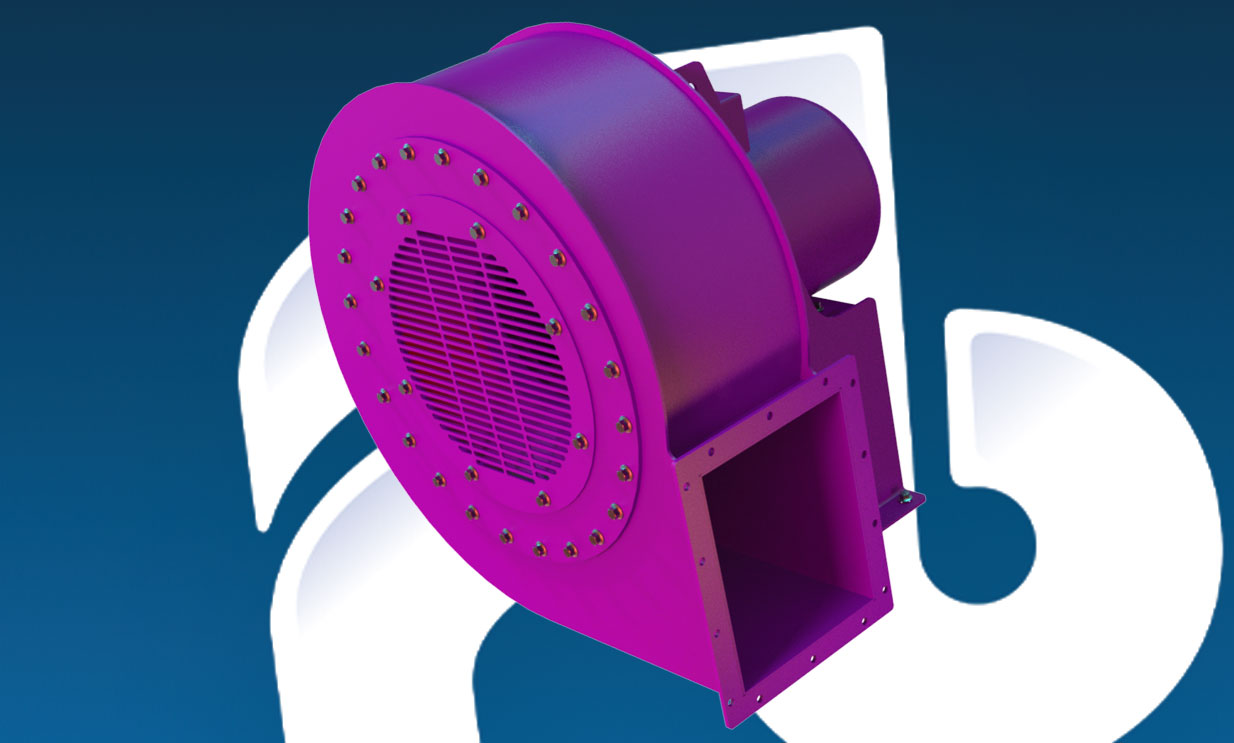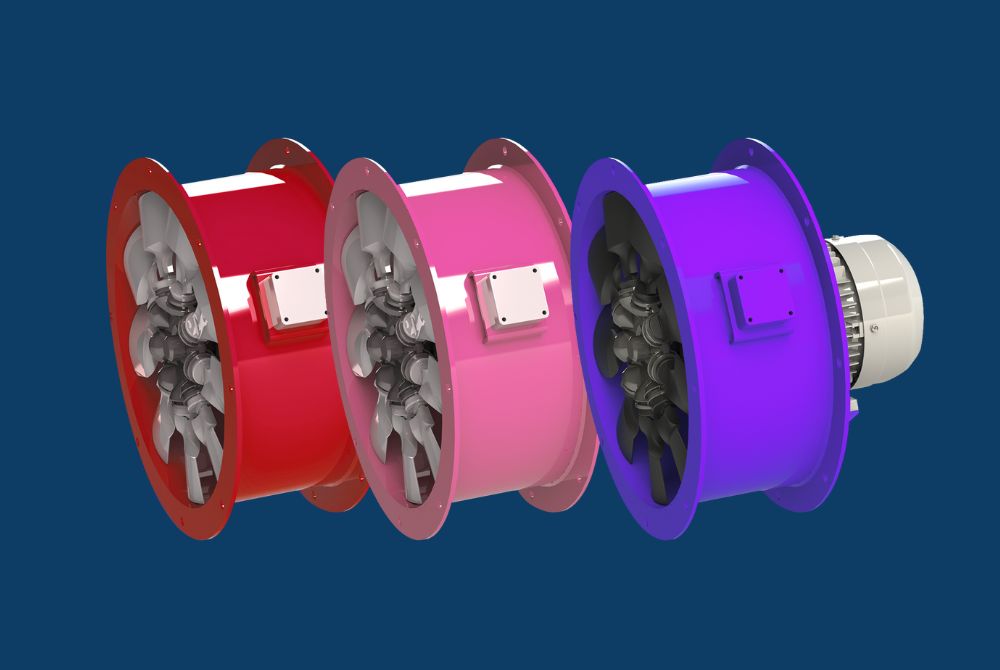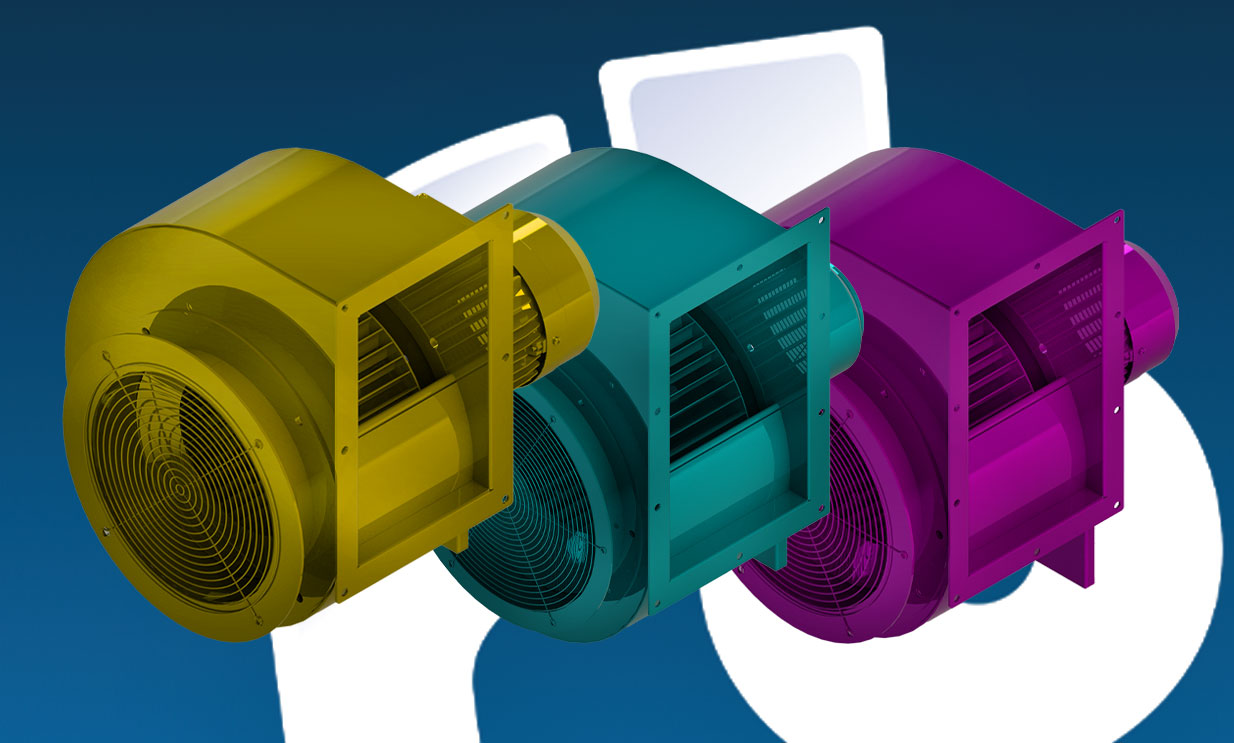
News
How Does a Centrifugal Fan Work? | Guide Explained Simply
13.05.2025
If you’re designing or upgrading an industrial ventilation system, one of the most important components is the fan. But how does a centrifugal fan work, and why is it preferred in many high-resistance air movement applications?
In this guide, we break down the core principles, components, and benefits of centrifugal fans—and why they are the top choice for many industrial and commercial settings.
What Is a Centrifugal Fan?
A centrifugal fan is a mechanical device that moves air or gases using centrifugal force. Air enters through the centre of the fan and is flung outward by a spinning impeller. This motion increases air pressure and redirects airflow at a 90-degree angle, making centrifugal fans ideal for ducted systems and resistance-heavy environments.
How Does a Centrifugal Fan Work?
Let’s walk through how a centrifugal fan works step-by-step:
- Air enters the fan via a central inlet.
- The impeller rotates, creating centrifugal force.
- Air is pushed outward from the impeller’s center to the edge.
- The housing directs the air out through the discharge port at a higher pressure and velocity.
Unlike axial fans—which move air in a straight line—centrifugal fans change the direction of airflow, allowing them to overcome greater resistance in ductwork or filtration systems.
Key Components in a Centrifugal Fan
Understanding how a centrifugal fan works means looking at its parts:
- Impeller: The rotating blade assembly that generates centrifugal force. Blade shapes (forward-curved, backward-curved, radial) affect airflow and pressure.
- Fan Housing (Volute): A spiral-shaped casing that channels and compresses air, increasing pressure before discharge.
- Motor: Powers the impeller. Available in direct-drive or belt-drive configurations.
- Inlet & Outlet: Air enters through the center and exits perpendicular to the intake.
Advantages of Using Centrifugal Fans
- High Static Pressure: Ideal for ducted systems or where airflow must overcome filters or resistance.
- Direction Control: Redirects airflow by 90°, ideal for compact or complex layouts.
- Quieter Operation: Especially backwards-curved fans in closed systems.
- Durable Design: Handles corrosive, dusty, or high-moisture environments.
- Energy Efficient: Engineered for consistent, reliable performance with minimal waste.
Common Applications of Centrifugal Fans
Centrifugal fans are widely used in:
- HVAC systems
- Dust and fume extraction
- Spray booths
- Drying systems
- Pharmaceutical & cleanroom exhausts
- Industrial process ventilation
Any application requiring reliable airflow through ductwork or equipment will benefit from centrifugal fans. Find out more uses here!
Why You Should Use a Centrifugal Fan
Understanding how a centrifugal fan works is key to designing an efficient air movement system. These fans deliver consistent pressure, reliable airflow, and versatile performance across a wide range of industrial applications.
At Fans and Blowers, we supply and design centrifugal fans that meet your specific performance needs—whether off-the-shelf or fully bespoke.
Talk to Our Experts
Need help choosing the right fan? Our team is here to help. Contact us for custom advice, specs, and a free quote.
Return To NewsKeep up to date with our
Latest News
-
Fans & Blowers Acquires B.O.B. Stevenson | Announcement
View more -
How Is the Centrifugal Blower Turned? Drive Types Explained
View more -
Types of Centrifugal Fans Explained | Industrial Fan Guide
View more -
Industrial Cooling Fans: How they work, Uses and Benefits
View more -
What is a Rotating Shaft on a fan? Applications and Benefits
View more -
Quiet Axial Fans | Low-Noise Industrial Fans with Silencers
View more -
Inlet & Outlet Fan Design | Improve Airflow and Efficiency
View more -
Expert Air Control Solution | Fans Built for Controlling Air
View more -
Fan Motors for Industrial Fans | Direct & Belt Drive Options
View more -
Fan Housing (Volute) Explained | Centrifugal Fan Efficiency
View more -
Fan Impeller Guide | Centrifugal Fan Impeller & Manufacturer
View more -
Compressed Air Safety with Industrial Fans and Blowers
View more -
How Does a Centrifugal Fan Work? | Guide Explained Simply
View more -
What Are Axial Flow Fans? | Industrial Ventilation Explained
View more -
Are Centrifugal Fans Quieter? | Noise Comparison & Benefits
View more -
What Are Centrifugal Fans? | Industrial Fans & Blowers Guide
View more -
What is HVAC? Understanding what HVAC stands for
View more -
How Does an Axial Fan Work? | Learn About Their Functions
View more -
What is ATEX? ATEX Equipment and Explosive Atmospheres
View more -
New Job Vacancy: Welder/Fabricator – Join Our F&B Team!
View more -
Fans and Blowers partner with FBG Servicing for expert industrial fan servicing
View more -
Celebrating National Engineers Week at Fans and Blowers
View more -
Fans & Blowers Introduce Side Channel Blowers to the roster!
View more -
Josh Roddick joins the team as F&B Production Manager!
View more -
A Christmas Message from All of Us at Fans and Blowers
View more -
Fans and Blowers Achieves Recertification ISO 14001 ISO 9001
View more -
Fans and Blowers for Air Knife Systems: Powerful Solutions
View more -
Everything You Need to Know About Axial HVAC Fans
View more -
Silencers for Fans: Reduce your Industrial Noise Levels
View more -
Inlet Filters: Maintain Clean Airflow and Protect Equipment
View more -
New Fans and Blowers Shop Now Live
View more -
Meet Fans and Blowers’ New Apprentice: Finley Huggins!
View more -
ATEX Explosion Proof Fan: Safety in Hazardous Environments
View more -
Discover Our Latest Product: Multivane Forward Curved Fans
View more -
How to Make an Industrial Fan Quiet: Tips and Techniques
View more -
What’s the Difference Between a Radial Fan vs Axial fan
View more -
Learning the importance of Fans & Blowers Industrial Blowers
View more -
Unlocking Reliability and Effectiveness with Bifurcated Fans
View more -
Ensuring Efficiency: The Value of Dust & Fume Extraction
View more -
Exploring the Functions of Gas Booster and Exhauster Fans
View more -
Unleashing the Potential of Axial Fans: Endless Applications
View more -
What are Axial Fans used for?
View more -
Our Fume Extract Fans are Clearing the Air of Hazardous Fumes
View more -
Unveiling ATEX Fans’ Vital Role in Hazardous Environments
View more -
How much electricity does an industrial fan use?
View more -
What is a Centrifugal Blower?
View more -
What is an Axial Fan?
View more -
What is a Centrifugal Fan used for?
View more -
New Vacancy: Welder/Fabricator
View more -
Axial Fans vs Centrifugal Fans
View more -
The advantages of Axial Fans
View more -
Industries that our industrial Fans and Blowers excel in
View more -
Celebrating 50 years of manufacturing
View more -
Introducing a world leading axial fan range
View more -
Centrifugal specialists
View more -
Laser cutting services
View more -
New digital media for 2022
View more -
On-site service and maintenance
View more -
On-site nitrogen production plant
View more -
Meet our new engineering Graduate
View more -
New factory signage
View more -
A fresh new look for our website
View more -
Duncan Celebrates 25 Years at Fans and Blowers
View more -
Weatherproof Acoustic Enclosure to meet noise restrictions
View more -
Fresh Look for the Flat Bed
View more -
BSZ Fans On Their Way To Europe
View more
PRODUCTS WITH EXCEPTIONAL PERFORMANCE
Our Range


Shop Fans
Shop our range of Multi-Vane FansWorldwide shipping
International standards
High performance


